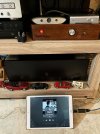i tried playing a hi-Res lossless track in the following four ways. Note that CXN was used as a pure streamer and the DAC was Schiit Bifrost in all cases to maintain uniformity:
A. From iPad via AirPlay2 to CXN
B. From MacBook via AirPlay2 from Music app to CXN
C. From MacBook via AirPlay2 system-wide (from menubar on top of screen) to CXN
D. From MacBook via USB directly to Schiit DAC.
The hi-Res (24-bit/48kHz ALAC) track I played:
View attachment 59830
Here are the findings:
A. From iPad via AirPlay2 to CXN; as well as
B. From MacBook via AirPlay2 from Music app to CXN
View attachment 59833
Now this is the confusing one because it says 44.1kHz/16 bit as well as AAC. Some of us think that AAC is necessarily lossy. But is it? Let’s look at that later. But the SQ (as well as the display on CXN) in these two cases was identical.
C. From MacBook via AirPlay2 system-wide (from menubar on top of screen) to CXN
View attachment 59835
As you can see, it says ALAC now. So clearly the AAC is enforced by the Apple Music app and not a limitation of AirPlay2. AirPlay2 is quite capable of transferring Lossless. That gives us the confidence that Apple only needs to make some software changes to its Apple Music app and/or iOS to be able to get ALAC transfers from iOS devices to our streamers and AVRs. Hopefully that’d happen soon.
But how was the SQ in this case? Perceivably better than in cases A and B (though I won’t say a day-night difference). So clearly it’s preferable. If you are on MacBook, there’s no reason to go with B and not C. Remember that even in C, AirPlay2 caps the transmission to 44.1kHz/16bit (hopefully that’d change with AirPlay3). But it should still be able to do full justice to CD quality lossless albums on Apple Music (which is what all Indian and most older international content is anyway in).
D. From MacBook via USB directly to Schiit DAC.
Now, my Schiit DAC doesn’t display the resolution so I can only guess. (Also no pic for the same reason). But given that it has the capability, there’s no reason to not believe that it was playing the hi-Res file as it is - that is, in its 24bit/48kHz glory. And the ears could easily tell that. The bump in SQ was quite obvious. After hearing it, it’s difficult NOT to play hi-Res via USB and go with AirPlay instead. I couldn’t locate a hi-Res file with further higher resolution than this one, but I imagine the improvement would only be more accentuated in that case.
Now, let’s get back to the confusion mentioned earlier. Does AAC necessarily mean lossy? I don’t know. But if you look at Wikipedia’s table comparing different codecs below, it shows that AAC can use MPEG-4 SLS lossless audio compression (something that mp3 doesn’t).

en.m.wikipedia.org
Now what is this MPEG-4 SLS? Probably more technically equipped members can read the following and explain it well, but SLS stands for ‘scalable to lossless’

en.m.wikipedia.org
As the article mentions, it’s an extension that allows having both a lossy layer and lossless correction layer. It can also work without a lossy layer. I quote - “On top of the core AAC codec, a scalable extension layer increases the signal-to-noise ratio, reaching lossless quality
at data rates comparable to those of pure lossless audio codecs, that is at average compression ratios of about 58%”.
Now, I cannot be sure, but probably this means that even AAC could potentially SQ approaching pure lossless. Definitely better than 320 kbps mp3. Question is, whether the AAC transferred by AirPlay uses both the lossy and lossless layer? If it does, probably CXN (and other receivers) take the lossless layer?
PS. I realised I could connect the MacBook directly to the CXN as well with USB. So i did that too as case E. it’s essentially a small variation of case D, just adding the CXN unnecessarily into the chain while the DAC in use still remained Schitt. This is what the display showed. I am assuming it was playing hi-Res version and the SQ was close to that of case D (with whatever deterioration due to the elongated path by addition of CXN streamer).
View attachment 59838



